NASA Sees Our Ocean In Color. How About You?
NASA Sees Our Ocean in Color. How About You?
Take a deep breath. Feel the oxygen in your lungs. We have the ocean to thank for that! Over long time scales, between 50 and 70 percent of our planet's oxygen is produced by microscopic organisms living in the ocean.

Today is World Oceans Day! And as our planet’s climate continues to change, we want to understand how one of our biggest ecosystems is changing with it. Wondering how you can celebrate with NASA? We’ve got downloadable coloring pages and online coloring interactives to show how we study the ocean. Read on.
From Space to Sea

Download ocean missions coloring page here Download Sentinel-6 Michael Freilich coloring page here
We use planes, boats, Earth-observing satellites and much more to study the ocean and partner with organizations all over the world. Here are a few examples:
From Sea
The Export Processes in the Ocean from Remote Sensing (EXPORTS) is one way we study the ocean from the sea to study changes in the ocean’s carbon cycle. In May, scientists and crew conducted research on three ships in the Northern Atlantic Ocean. They hope to create models to better understand climate change patterns.
From Space
Launched last year, the Sentinel-6 Michael Freilich spacecraft began a five-and-a-half-year prime mission to collect the most accurate data yet on global sea level and how our oceans are rising in response to climate change. Sentinel-6 Michael Freilich is just one of many satellites monitoring the ocean from space. Together with other Earth-observing spacecraft, the mission will also collect precise data of atmospheric temperature and humidity to help improve weather forecasts and climate models.
Finding Eddies

Download Eddies Coloring Page The ocean is full of eddies – swirling water masses that look like hurricanes in the atmosphere. Eddies are often hot spots for biological activity that plays an important role in absorbing carbon. . We find eddies by looking for small changes in the height of the ocean surface, using multiple satellites continuously orbiting Earth. We also look at eddies up close, using ships and planes to study their role in the carbon cycle.
Monitoring Aerosols and Clouds

Clouds coloring interactive here
Aerosols coloring interactive here
Tiny particles in the air called aerosols interact with clouds. These interactions are some of the most poorly understood components of Earth's climate system. Clouds and aerosols can absorb, scatter or reflect incoming radiation -- heat and light from the Sun -- depending on their type, abundance and locations in the atmosphere. We’re building new instruments to better understand aerosols and contribute to air quality forecasts.
The Ocean in Living Color Download PACE coloring page here

The Plankton, Aerosol, Cloud, ocean Ecosystem (PACE) mission will continue and greatly advance observations of global ocean color, biogeochemistry, and ecology, as well as Earth’s carbon cycle and atmospheric aerosols and clouds. It’s set to launch in late 2023 to early 2024. Want to learn more? Click here to see how PACE will collect data and here to see what PACE will see through our coloring interactives. (Make sure to check out the hidden surprises in both!)
Exploring Ocean Worlds on Earth and Beyond
Download Clouds coloring page here

Using our understanding of oceans on Earth, we also study oceans on other planets. Mars, for example, contains water frozen in the ice caps or trapped beneath the soil. But there’s even more water out there. Planets and moons in our solar system and beyond have giant oceans on their surface. Saturn’s moon Enceladus is thought to have a massive ocean under its frozen surface, which sometimes sprays into space through massive fissures in the ice.
Learn more about ocean worlds here: nasa.gov/oceanworlds
Interested in learning more about how NASA studies oceans? Follow @NASAClimate, @NASAOcean and @NASAEarth.
You can also find all the coloring pages and interactives here.
Make sure to follow us on Tumblr for your regular dose of space: http://nasa.tumblr.com.
More Posts from Nasa and Others
10 “Out of This World" Facts About the James Webb Space Telescope
Wouldn’t it be neat to see a period of the universe’s history that we’ve never seen before? That’s exactly what the James Webb Space Telescope (JWST) will be able to do…plus more!
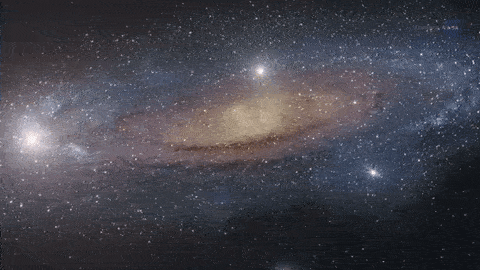
Specifically, Webb will see the first objects that formed as the universe cooled down after the Big Bang. We don’t know exactly when the universe made the first stars and galaxies – or how for that matter. That is what we are building Webb to help answer.
Here are 10 awesome facts about this next generation space telescope:
1. The James Webb Space Telescope is the world’s largest and next premier space observatory. It will extend the discoveries of the Hubble Space telescope and observe the birthplaces of stars, galaxies, planets and life over billions of years.

2. It is named after James Webb, NASA’s second administrator and champion of our science.

3. At 3 stories high and the size of a tennis court, it will be 100 times more powerful than Hubble!

4. It is so big that it has to fold origami-style to fit in the rocket, which is only 5.4 meters wide...And then it will unfurl, segment by segment, once in space.

5. The telescope will observe infrared light with unprecedented sensitivity. It will see the first galaxies born after the Big Bang over 13.5 billion years ago.

6. Webb's infrared cameras are so sensitive they must be shielded from light from the sun, Earth, and moon. The 5-layer sunshield is like having sunblock of SPF 1 million.

7. Webb will orbit the sun 1 million miles from Earth, where the telescope will operate at temperatures below -390 F (-235 C).

8. Webb’s mirrors are coated with a super thin layer of gold only about 1000 atoms thick to optimize their reflectivity in the infrared.

9. Webb will launch from French Guiana in 2018. It is launched near the equator because the faster spin of Earth there gives the rocket an extra push.

10. Webb is an international mission, with contributions from the European Space Agency and Canadian Space Agency. Once operational, scientists from all over the world will be able to use Webb to explore our solar system, planets outside our solar system, stars and galaxies.

Make sure to follow us on Tumblr for your regular dose of space: http://nasa.tumblr.com
Black Marble: NASA View Illuminates Earth at Night
When the sun goes down, the lights on Earth shine bright. A new look using our satellite data captures the lights coming from our neighborhoods, vehicles, buildings, factories, fishing vessels and other human activity brightening the night.

Our scientists have just released the first new global map of Earth at night since 2012. This nighttime view of our home planet, dubbed the Black Marble, provides researchers with a unique perspective of human activities around the globe.
By studying Earth at night, researchers can investigate how and why cities expand, monitor light intensity to estimate energy use and economic activity, and aid in disaster response in near-real time.

The data on Earth at night comes from the Visible Infrared Imaging Radiometer Suite (VIIRS) instrument on the Suomi National Polar-orbiting Partnership satellite, jointly managed by NASA and the National Oceanic and Atmospheric Administration (NOAA).
VIIRS captures visible and infrared light, allowing researchers to glimpse the Earth as it looks to astronauts peering out of the International Space Station. The new map is a composite of data collected in 2016, and it took several months of processing to filter out clouds, moonlight, airglow, and other interfering features to create the global image. In the coming months our scientists will release daily nighttime lights data at even finer resolutions for the first time.

The East Coast sparkles with population hubs, suburbs circling cities and major roadways. The I-95 corridor includes the most densely populated region of the United States – the stretch from Washington, DC to Boston.
To get images like these from the satellite data, our scientists had to filter out moonlight, aerosols and other sources of extraneous light – the goal is to eventually be able to detect the lights from a single building or fishing boat.

Daytime satellite images, like this one from Landsat 8, can show us the forests, deserts, mountains, waterways and built-up cities. Add a nighttime view, and scientists can study when and how people are using these limited resources – like the lights tracing the Nile River leading to the metropolis of Cairo, Egypt.

Lights aren’t confined to land. With the global nighttime view, the ocean is dotted with fishing fleets, including boats that try to attract their catch with bright lights.

What lights illuminate your neighborhood? Download a high-resolution version of the Black Marble HERE, and find out more about our new night lights data HERE.
Make sure to follow us on Tumblr for your regular dose of space: http://nasa.tumblr.com
Meet Our Latest CubeSats
When the next Orbital ATK cargo mission to the International Space Station blasts off from Wallops Flight Facility in Virginia on May 20 at 5:04 a.m. EDT carrying science and supplies, the Cygnus spacecraft will also be carrying a few of our latest CubeSats.

The International Space Station is often used to deploy small satellites, a low-cost way to test technology and science techniques in space.

On board this time, for deployment later this summer, are...
The ‘Rabbit’ in the RainCube
As its name suggests, RainCube will use radar to measure rain and snowfall. CubeSats are measured in increments of 1U (A CubeSat unit, or 1U, is roughly equivalent to a 4-inch box, or 10x10x10 centimeters). The RainCube antenna has to be small enough to be crammed into a 1.5U container; the entire satellite is about as big as a cereal box.
"It's like pulling a rabbit out of a hat," said Nacer Chahat, a specialist in antenna design at our Jet Propulsion Laboratory. "Shrinking the size of the radar is a challenge for us. As space engineers, we usually have lots of volume, so building antennas packed into a small volume isn't something we're trained to do."

That small antenna will deploy in space, like an upside-down umbrella. To maintain its small size, the antenna relies on the high-frequency Ka-band wavelength – good for profiling rain and snow. Ka-band also allows for an exponential increase in sending data over long distances, making it the perfect tool for telecommunications.
Peering Into Clouds

TEMPEST-D will also study weather. Temporal Experiment for Storms and Tropical Systems – Demonstration (TEMPEST-D) has satellite technology with the potential to measure cloud and precipitation processes on a global basis. These measurements help improve understanding of Earth’s water cycle and weather predictions, particularly conditions inside storms.

TEMPEST-D millimeter-wave observations have the ability to penetrate into clouds to where precipitation initiation occurs. By measuring the evolution of clouds from the moment of the onset of precipitation, a future TEMPEST constellation mission could improve weather forecasting and improve our understanding of cloud processes, essential to understanding climate change.
Cutting Through the Noise

CubeRRT, also the size of a cereal box, will space test a small component designed to detect and filter radio frequency interference (RFI). RFI is everywhere, from cellphones, radio and TV transmissions, satellite broadcasts and other sources. You probably recognize it as that annoying static when you can’t seem to get your favorite radio station to come in clearly because another station is nearby on the dial.

The same interference that causes radio static also affects the quality of data that instruments like microwave radiometers collect. As the number of RFI-causing devices increases globally, our satellite instruments – specifically, microwave radiometers that gather data on soil moisture, meteorology, climate and more – will be more challenged in collecting high-quality data.
That’s where CubeSat Radiometer Radio frequency interference Technology (CubeRRT) comes in. The small satellite will be carrying a new technology to detect and filter any RFI the satellite encounters in real-time from space. This will reduce the amount of data that needs to be transmitted back to Earth – increasing the quality of important weather and climate measurements.
Searching the Halo of the Milky Way

Did you know that we’re still looking for half of the normal matter that makes up the universe? Scientists have taken a census of all the stars, galaxies and clusters of galaxies — and we’re coming up short, based on what we know about the early days of the cosmos.
That missing matter might be hiding in tendrils of hot gas between galaxies. Or it might be in the halos of hot gas around individual galaxies like our own Milky Way. But if it’s there, why haven’t we seen it? It could be that it’s so hot that it glows in a spectrum of X-rays we haven’t looked at before.

Image Credit: Blue Canyon Technologies
Enter HaloSat. Led by the University of Iowa, HaloSat will search the halo of the Milky Way for the emissions oxygen gives off at these very high temperatures. Most other X-ray satellites look at narrow patches of the sky and at individual sources. HaloSat will look at large swaths of the sky at a time, which will help us figure out the geometry of the halo — whether it surrounds the galaxy more like a fried egg or a sphere. Knowing the halo’s shape will in turn help us figure out the mass, which may help us discover if the universe’s missing matter is in galactic halos.
CubeSats for All
Small satellites benefit Earth and its people (us!) in multiple ways. From Earth imaging satellites that help meteorologists to predict storm strengths and direction, to satellites that focus on technology demonstrations to help determine what materials function best in a microgravity environment, the science enabled by CubeSats is diverse.

They are also a pathway to space science for students. Our CubeSat Launch initiative (CSLI) provides access to space for small satellites developed by our Centers and programs, educational institutions and nonprofit organizations. Since the program began, more than 50 educational CubeSats have flown. In 2016, students built the first CubeSat deployed into space by an elementary school.
Learn more about CubeSats HERE.
Make sure to follow us on Tumblr for your regular dose of space: http://nasa.tumblr.com.
Get to Know the 5 College Teams Sending Their Experiments to Space!
Did you know that YOU (yes you!), can send science experiments to the International Space Station?
To celebrate 20 years of continuous human presence on the International Space Station, NASA STEM on Station is sending five student experiments to the space station through Student Payload Opportunity with Citizen Science (SPOCS). Selected teams will also engage K-12 students as a part of their experiment through citizen-science.
Get to know the 5 college teams sending their experiments to space!
Arkansas State University
Team: A-State Science Support System

Experiment Title: Microgravity Environment Impact on Plastic Biodegradation by Galleria mellonella
Experiment Description: Discover the ability of wax worms to degrade plastics in space.
Why did you propose this experiment?
Our team’s passion for sustainability developed into novel ideas for space travel through biodegradation of plastics.
How will the experiment benefit humankind or future space exploration?
If our experiment is successful, it will “launch” us closer to understanding how to reduce humankind’s plastic footprint on Earth and allow us to safely push farther into unknown planetary habitats.
How have you worked together as a team during the pandemic?
Unknown to each other before the project, our interdisciplinary team formed through virtual communication.
What science fiction character best represents your team and why?
The sandworms of Dune represent our team perfectly considering their importance in space travel, the natural ecological service they provide, and their sheer awesomeness
Columbia University
Team: Columbia Space Initiative

Experiment Title: Characterizing Antibiotic Resistance in Microgravity Environments (CARMEn)
Experiment Description: Discover the impact of mutations on bacteria in microgravity when grown into a biofilm with fungus.
Why did you propose this experiment?
As a highly interdisciplinary team united by our love of outer space, SPOCS was the perfect opportunity to fuse biology, engineering, and education into a meaningful team project.
How will the experiment benefit humankind or future space exploration?
Studying how different microorganisms interact with each other to develop bacterial resistance in space will help improve antibiotic treatments for future Artemis astronauts.
How have you worked together as a team during the pandemic?
Most of our team actually hasn’t ever met in person—we’ve been videoconferencing weekly since May!
What science fiction character best represents your team and why?
Our team is definitely Buzz Lightyear from Toy Story, because we strive to reach infinity (or at least the International Space Station) and beyond!
Stanford University
Team: Stanford Student Space Initiative

Experiment Title: Biopolymer Research for In-Situ Capabilities (BRIC)
Experiment Description: Determine how microgravity impacts the solidification of biobricks.
Why did you propose this experiment?
We have an ongoing project to design and build a machine that turns lunar or Martian soil into bricks, and we want to learn how reduced gravity will impact the process.
How will the experiment benefit humankind or future space exploration?
We are studying an environmentally-friendly concrete alternative that can be used to make structures on Earth and other planets out of on-site, readily available resources.
How have you worked together as a team during the pandemic?
We transitioned our weekly meetings to an online format so that we could continue at our planned pace while maintaining our community.
What science fiction character best represents your team and why?
Like our beloved childhood friend WALL-E, we craftily make inhospitable environments suitable for life with local resources.
University of Idaho
Team: Vandal Voyagers I

Experiment Title: Bacteria Resistant Polymers in Microgravity
Experiment Description: Determine how microgravity impacts the efficacy of bacteria resistant polymers.
Why did you propose this experiment?
The recent emphasis on surface sterility got us thinking about ways to reduce the risk of disease transmission by surfaces on the International Space Station.
How will the experiment benefit humankind or future space exploration?
If successful, the application of proposed polymers can benefit humankind by reducing transmission through high contact surfaces on and off Earth such as hand rails and door handles.
How have you worked together as a team during the pandemic?
We are allowed to work collaboratively in person given we follow the current university COVID guidelines.
What science fiction character best represents your team and why?
Mark Watney from The Martian because he is willing to troubleshoot and problem solve on his own while collaborating with NASA from afar.
University of New Hampshire at Manchester
Team: Team Cooke

Experiment Title: Novel Methods of Antibiotic Discovery in Space (NoMADS)
Experiment Description: Determine how microgravity impacts the amount of bacterium isolates that produce antibiotic metabolites.
Why did you propose this experiment?
To contribute to the limited body of knowledge regarding bacterial resistance and mutations in off-Earth conditions.
How will the experiment benefit humankind or future space exploration?
Understanding how bacteria in the human microbiome and on spacecraft surfaces change can ensure the safe and accurate treatment of bacterial infections in astronauts.
How have you worked together as a team during the pandemic?
Our team continued to evolve our communication methods throughout the pandemic, utilizing frequent remote video conferencing, telecommunications, email, and in-person conferences.
What science fiction character best represents your team and why?
Professor Xavier, the founder of the X-Men, because he also works with mutants and feels that while they are often misunderstood, under the right circumstances they can greatly benefit the world.
Make sure to follow us on Tumblr for your regular dose of space: http://nasa.tumblr.com.
Space Gardening 101
You can’t escape eating (or gardening!) your vegetables, even if you’re in space. On Aug. 10, astronauts on the International Space Station sampled their first space grown salad. This freshly harvest red romaine lettuce was grown in the “Veggie” plant growth chamber that is designed to make gardens flourish in weightlessness.
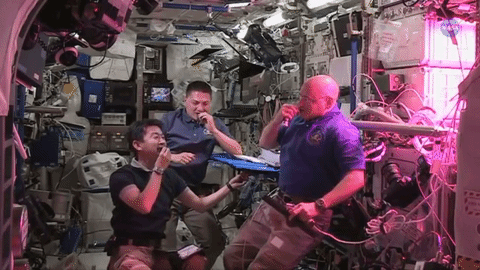
In a weightless environment, there is no up and down, so roots grow in all directions. Water and soil, the materials used to anchor these plants and allow for root growth tend to float away.
How Do We Grow Plants in Space?
1. Plant Pillows
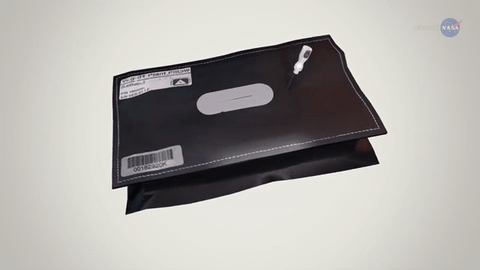
The Veggie chamber helps solve the problems of a weightless environment by using ‘plant pillows’, sounds comfy right? These pillows are bags filled with material for growing plants in space.
2. Wicks

Wicks are implanted into the bags and are used to draw water from inside the pillow to the plant.
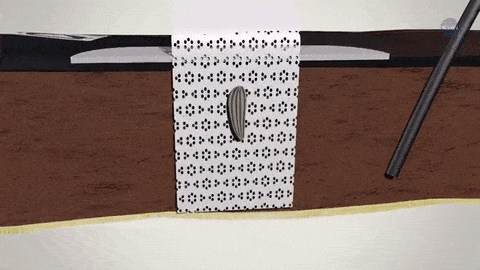
These wicks also provide a place to glue the seeds. It’s important to orient the seeds so roots will grow ‘down’, and shoots that emerge will push out of the bag.
3. LED Lights
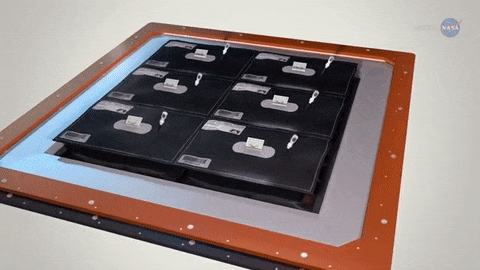
LED lights are used for photosynthesis and give the shoots a sense of direction so they keep growing upward. The walls of the Veggie chamber can expand to make room for the plant as it grows.
The purple/pinkish hue surrounding the plants in Veggie is the result of a combination of the red and blue lights, which is what the plants need to grow. Green LEDS were added so the plants look like edible food rather than weird purple plants.
Why are we growing plants in space?
When astronauts travel on deep space missions, like Mars, they will need to be self-sufficient for long periods of time. Having the ability to grow their own food is a big step in that direction. There is also a desire to grow flowering vegetables in space, which is why we are currently tending to zinnia flowers on orbit. Growing these flowering plants will help us understand longer duration growing plants that have to flower in space, such as tomatoes.
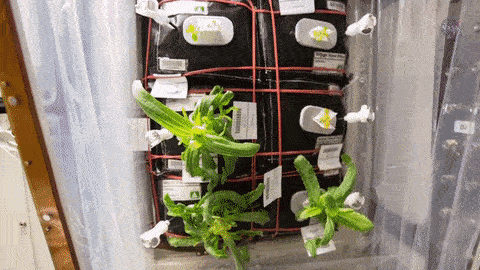
What’s Next? The next SpaceX delivery will include seeds for a small cabbage and additional red romaine lettuce. Upcoming experiments will use various ratios of red and blue lights and different fertilizers in attempts to improve crop yield, nutrition and flavor. The findings from these experiments can be utilized both on Earth and in space.
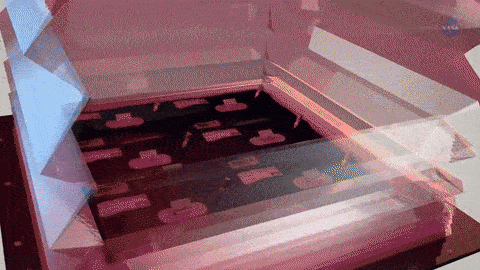
In addition to the nutrition benefits of growing vegetables in space, the psychological benefits are also significant. Having living plants can help with stress and increase the crews’ enjoyment. It provides the sights, smells and tastes of Earth.
To learn more about gardening in space, watch ScienceCast HERE.
Make sure to follow us on Tumblr for your regular dose of space: http://nasa.tumblr.com
Pi Guides the Way
It may be irrational but pi plays an important role in the everyday work of scientists at NASA.

What Is Pi ?
Pi is the ratio of a circle’s circumference to its diameter. It is also an irrational number, meaning its decimal representation never ends and it never repeats. Pi has been calculated to more than one trillion digits,
Why March 14?
March 14 marks the yearly celebration of the mathematical constant pi. More than just a number for mathematicians, pi has all sorts of applications in the real world, including on our missions. And as a holiday that encourages more than a little creativity – whether it’s making pi-themed pies or reciting from memory as many of the never-ending decimals of pi as possible (the record is 70,030 digits).

While 3.14 is often a precise enough approximation, hence the celebration occurring on March 14, or 3/14 (when written in standard U.S. month/day format), the first known celebration occurred in 1988, and in 2009, the U.S. House of Representatives passed a resolution designating March 14 as Pi Day and encouraging teachers and students to celebrate the day with activities that teach students about pi.
5 Ways We Use Pi at NASA
Below are some ways scientists and engineers used pi.

Keeping Spacecraft Chugging Along
Propulsion engineers use pi to determine the volume and surface area of propellant tanks. It’s how they size tanks and determine liquid propellant volume to keep spacecraft going and making new discoveries.

Getting New Perspectives on Saturn
A technique called pi transfer uses the gravity of Titan’s moon, Titan, to alter the orbit of the Cassini spacecraft so it can obtain different perspectives of the ringed planet.

Learning the Composition of Asteroids
Using pi and the asteroid’s mass, scientists can calculate the density of an asteroid and learn what it’s made of--ice, iron, rock, etc.

Measuring Craters
knowing the circumference, diameter and surface area of a crater can tell scientists a lot about the asteroid or meteor that may have carved it out.

Determining the Size of Exoplanets
Exoplanets are planets that orbit suns other than our own and scientists use pi to search for them. The first step is determining how much the light curve of a planet’s sun dims when a suspected planets passes in front of it.
Want to learn more about Pi? Visit us on Pinterest at: https://www.pinterest.com/nasa/pi-day/
Make sure to follow us on Tumblr for your regular dose of space: http://nasa.tumblr.com
Black Scientists and Engineers Past and Present Enable NASA Space Telescope
The Nancy Grace Roman Space Telescope is NASA’s next flagship astrophysics mission, set to launch by May 2027. We’re currently integrating parts of the spacecraft in the NASA Goddard Space Flight Center clean room.
Once Roman launches, it will allow astronomers to observe the universe like never before. In celebration of Black History Month, let’s get to know some Black scientists and engineers, past and present, whose contributions will allow Roman to make history.

Dr. Beth Brown
The late Dr. Beth Brown worked at NASA Goddard as an astrophysicist. in 1998, Dr. Brown became the first Black American woman to earn a Ph.D. in astronomy at the University of Michigan. While at Goddard, Dr. Brown used data from two NASA X-ray missions – ROSAT (the ROentgen SATellite) and the Chandra X-ray Observatory – to study elliptical galaxies that she believed contained supermassive black holes.
With Roman’s wide field of view and fast survey speeds, astronomers will be able to expand the search for black holes that wander the galaxy without anything nearby to clue us into their presence.

Dr. Harvey Washington Banks
In 1961, Dr. Harvey Washington Banks was the first Black American to graduate with a doctorate in astronomy. His research was on spectroscopy, the study of how light and matter interact, and his research helped advance our knowledge of the field. Roman will use spectroscopy to explore how dark energy is speeding up the universe's expansion.

NOTE - Sensitive technical details have been digitally obscured in this photograph.
Sheri Thorn
Aerospace engineer Sheri Thorn is ensuring Roman’s primary mirror will be protected from the Sun so we can capture the best images of deep space. Thorn works on the Deployable Aperture Cover, a large, soft shade known as a space blanket. It will be mounted to the top of the telescope in the stowed position and then deployed after launch. Thorn helped in the design phase and is now working on building the flight hardware before it goes to environmental testing and is integrated to the spacecraft.

Sanetra Bailey
Roman will be orbiting a million miles away at the second Lagrange point, or L2. Staying updated on the telescope's status and health will be an integral part of keeping the mission running. Electronics engineer Sanetra Bailey is the person who is making sure that will happen. Bailey works on circuits that will act like the brains of the spacecraft, telling it how and where to move and relaying information about its status back down to Earth.
Learn more about Sanetra Bailey and her journey to NASA.

Dr. Gregory Mosby
Roman’s field of view will be at least 100 times larger than the Hubble Space Telescope's, even though the primary mirrors are the same size. What gives Roman the larger field of view are its 18 detectors. Dr. Gregory Mosby is one of the detector scientists on the Roman mission who helped select the flight detectors that will be our “eyes” to the universe.
Dr. Beth Brown, Dr. Harvey Washington Banks, Sheri Thorn, Sanetra Bailey, and Dr. Greg Mosby are just some of the many Black scientists and engineers in astrophysics who have and continue to pave the way for others in the field. The Roman Space Telescope team promises to continue to highlight those who came before us and those who are here now to truly appreciate the amazing science to come.

To stay up to date on the mission, check out our website and follow Roman on X and Facebook.
Make sure to follow us on Tumblr for your regular dose of space!
A Tour of Storms Across the Solar System

Earth is a dynamic and stormy planet with everything from brief, rumbling thunderstorms to enormous, raging hurricanes, which are some of the most powerful and destructive storms on our world. But other planets also have storm clouds, lightning — even rain, of sorts. Let’s take a tour of some of the unusual storms in our solar system and beyond.
Tune in May 22 at 3 p.m. for more solar system forecasting with NASA Chief Scientist Jim Green during the latest installment of NASA Science Live: https://www.nasa.gov/nasasciencelive.

1. At Mercury: A Chance of Morning Micrometeoroid Showers and Magnetic ‘Tornadoes’
Mercury, the planet nearest the Sun, is scorching hot, with daytime temperatures of more than 800 degrees Fahrenheit (about 450 degrees Celsius). It also has weak gravity — only about 38% of Earth's — making it hard for Mercury to hold on to an atmosphere.
Its barely there atmosphere means Mercury doesn’t have dramatic storms, but it does have a strange "weather" pattern of sorts: it’s blasted with micrometeoroids, or tiny dust particles, usually in the morning. It also has magnetic “tornadoes” — twisted bundles of magnetic fields that connect the planet’s magnetic field to space.

2. At Venus: Earth’s ‘Almost’ Twin is a Hot Mess
Venus is often called Earth's twin because the two planets are similar in size and structure. But Venus is the hottest planet in our solar system, roasting at more than 800 degrees Fahrenheit (430 degrees Celsius) under a suffocating blanket of sulfuric acid clouds and a crushing atmosphere. Add to that the fact that Venus has lightning, maybe even more than Earth.
In visible light, Venus appears bright yellowish-white because of its clouds. Earlier this year, Japanese researchers found a giant streak-like structure in the clouds based on observations by the Akatsuki spacecraft orbiting Venus.

3. At Earth: Multiple Storm Hazards Likely
Earth has lots of storms, including thunderstorms, blizzards and tornadoes. Tornadoes can pack winds over 300 miles per hour (480 kilometers per hour) and can cause intense localized damage.
But no storms match hurricanes in size and scale of devastation. Hurricanes, also called typhoons or cyclones, can last for days and have strong winds extending outward for 675 miles (1,100 kilometers). They can annihilate coastal areas and cause damage far inland.

4. At Mars: Hazy with a Chance of Dust Storms
Mars is infamous for intense dust storms, including some that grow to encircle the planet. In 2018, a global dust storm blanketed NASA's record-setting Opportunity rover, ending the mission after 15 years on the surface.
Mars has a thin atmosphere of mostly carbon dioxide. To the human eye, the sky would appear hazy and reddish or butterscotch colored because of all the dust suspended in the air.

5. At Jupiter: A Shrinking Icon
It’s one of the best-known storms in the solar system: Jupiter’s Great Red Spot. It’s raged for at least 300 years and was once big enough to swallow Earth with room to spare. But it’s been shrinking for a century and a half. Nobody knows for sure, but it's possible the Great Red Spot could eventually disappear.

6. At Saturn: A Storm Chasers Paradise
Saturn has one of the most extraordinary atmospheric features in the solar system: a hexagon-shaped cloud pattern at its north pole. The hexagon is a six-sided jet stream with 200-mile-per-hour winds (about 322 kilometers per hour). Each side is a bit wider than Earth and multiple Earths could fit inside. In the middle of the hexagon is what looks like a cosmic belly button, but it’s actually a huge vortex that looks like a hurricane.
Storm chasers would have a field day on Saturn. Part of the southern hemisphere was dubbed "Storm Alley" by scientists on NASA's Cassini mission because of the frequent storm activity the spacecraft observed there.

7. At Titan: Methane Rain and Dust Storms
Earth isn’t the only world in our solar system with bodies of liquid on its surface. Saturn’s moon Titan has rivers, lakes and large seas. It’s the only other world with a cycle of liquids like Earth’s water cycle, with rain falling from clouds, flowing across the surface, filling lakes and seas and evaporating back into the sky. But on Titan, the rain, rivers and seas are made of methane instead of water.
Data from the Cassini spacecraft also revealed what appear to be giant dust storms in Titan’s equatorial regions, making Titan the third solar system body, in addition to Earth and Mars, where dust storms have been observed.

8. At Uranus: A Polar Storm
Scientists were trying to solve a puzzle about clouds on the ice giant planet: What were they made of? When Voyager 2 flew by in 1986, it spotted few clouds. (This was due in part to the thick haze that envelops the planet, as well as Voyager's cameras not being designed to peer through the haze in infrared light.) But in 2018, NASA’s Hubble Space Telescope snapped an image showing a vast, bright, stormy cloud cap across the north pole of Uranus.

9. At Neptune: Methane Clouds
Neptune is our solar system's windiest world. Winds whip clouds of frozen methane across the ice giant planet at speeds of more than 1,200 miles per hour (2,000 kilometers per hour) — about nine times faster than winds on Earth.
Neptune also has huge storm systems. In 1989, NASA’s Voyager 2 spotted two giant storms on Neptune as the spacecraft zipped by the planet. Scientists named the storms “The Great Dark Spot” and “Dark Spot 2.”

10. It’s Not Just Us: Extreme Weather in Another Solar System
Scientists using NASA’s Hubble Space Telescope made a global map of the glow from a turbulent planet outside our solar system. The observations show the exoplanet, called WASP-43b, is a world of extremes. It has winds that howl at the speed of sound, from a 3,000-degree-Fahrenheit (1,600-degree-Celsius) day side, to a pitch-black night side where temperatures plunge below 1,000 degrees Fahrenheit (500 degrees Celsius).
Discovered in 2011, WASP-43b is located 260 light-years away. The planet is too distant to be photographed, but astronomers detected it by observing dips in the light of its parent star as the planet passes in front of it.
Make sure to follow us on Tumblr for your regular dose of space: http://nasa.tumblr.com.
What did you major in? What was your college experience?
Hubble Space Telescope
You’ve probably heard of our Hubble Space Telescope, but have you had the chance to actually take a look at the amazing images it has captured for us over the years? Since Hubble launched in April 1990, it has made more than 1.2 million observations, some to locations more than 13.4 billion light years from Earth!
Hubble can see astronomical objects with an angular size of 0.05 arc seconds, which is like seeing a pair of fireflies in Tokyo from your home in Maryland…yea, that’s pretty far! This accuracy allows us to see images like this one of Little Gem Nebula, roughly 6,000 light-years away from us.

Images from Hubble are regularly released to the public, and are some of the most breathtaking views in the Universe. Images like this one of Lagoon Nebula, in the constellation of Sagittarius, not only make for amazing desktop screen-savers, but provide us with valuable scientific information about distant stars and galaxies, as well as the planets in our solar system.

We recently celebrated Hubble’s 25th Anniversary, and look forward to many more years of discovery and captivating images.
-
 luminousluciano reblogged this · 11 months ago
luminousluciano reblogged this · 11 months ago -
 idee-montijo liked this · 2 years ago
idee-montijo liked this · 2 years ago -
 eiliesplants reblogged this · 2 years ago
eiliesplants reblogged this · 2 years ago -
 jarsofplanets liked this · 2 years ago
jarsofplanets liked this · 2 years ago -
 aerospace-girl liked this · 2 years ago
aerospace-girl liked this · 2 years ago -
 appla1 reblogged this · 3 years ago
appla1 reblogged this · 3 years ago -
 scrumptioushairdoghostoperator liked this · 3 years ago
scrumptioushairdoghostoperator liked this · 3 years ago -
 nimzay1dstar reblogged this · 3 years ago
nimzay1dstar reblogged this · 3 years ago -
 kekheshan-kalim liked this · 3 years ago
kekheshan-kalim liked this · 3 years ago -
 mrclaw61 liked this · 3 years ago
mrclaw61 liked this · 3 years ago -
 artemis-ncc1701d reblogged this · 3 years ago
artemis-ncc1701d reblogged this · 3 years ago -
 artemis-ncc1701d liked this · 3 years ago
artemis-ncc1701d liked this · 3 years ago -
 swimmingbirdrunningrock reblogged this · 3 years ago
swimmingbirdrunningrock reblogged this · 3 years ago -
 lathaniel-james liked this · 3 years ago
lathaniel-james liked this · 3 years ago -
 quiqueteq liked this · 3 years ago
quiqueteq liked this · 3 years ago -
 yesjhworld liked this · 3 years ago
yesjhworld liked this · 3 years ago -
 krishchikhiabani liked this · 3 years ago
krishchikhiabani liked this · 3 years ago -
 doglover502 liked this · 3 years ago
doglover502 liked this · 3 years ago -
 fool-osophie liked this · 3 years ago
fool-osophie liked this · 3 years ago -
 accio-mywill-to-live liked this · 3 years ago
accio-mywill-to-live liked this · 3 years ago -
 devylprickq reblogged this · 3 years ago
devylprickq reblogged this · 3 years ago -
 nobeerreviews liked this · 3 years ago
nobeerreviews liked this · 3 years ago -
 delightfulpaperpost liked this · 3 years ago
delightfulpaperpost liked this · 3 years ago -
 wyomingnot reblogged this · 3 years ago
wyomingnot reblogged this · 3 years ago -
 myessenceconsistsofdeadmemes liked this · 3 years ago
myessenceconsistsofdeadmemes liked this · 3 years ago -
 sarrahsierra liked this · 3 years ago
sarrahsierra liked this · 3 years ago -
 virtualzonkslimepickle liked this · 3 years ago
virtualzonkslimepickle liked this · 3 years ago -
 mysticnaturedesignstudent liked this · 3 years ago
mysticnaturedesignstudent liked this · 3 years ago -
 theelectricginmachine reblogged this · 3 years ago
theelectricginmachine reblogged this · 3 years ago -
 weird-is-all-ive-got reblogged this · 3 years ago
weird-is-all-ive-got reblogged this · 3 years ago -
 omlette87 reblogged this · 3 years ago
omlette87 reblogged this · 3 years ago -
 kimbermcleod reblogged this · 3 years ago
kimbermcleod reblogged this · 3 years ago -
 kimbermcleod liked this · 3 years ago
kimbermcleod liked this · 3 years ago -
 daylight-moon reblogged this · 3 years ago
daylight-moon reblogged this · 3 years ago
Explore the universe and discover our home planet with the official NASA Tumblr account
1K posts